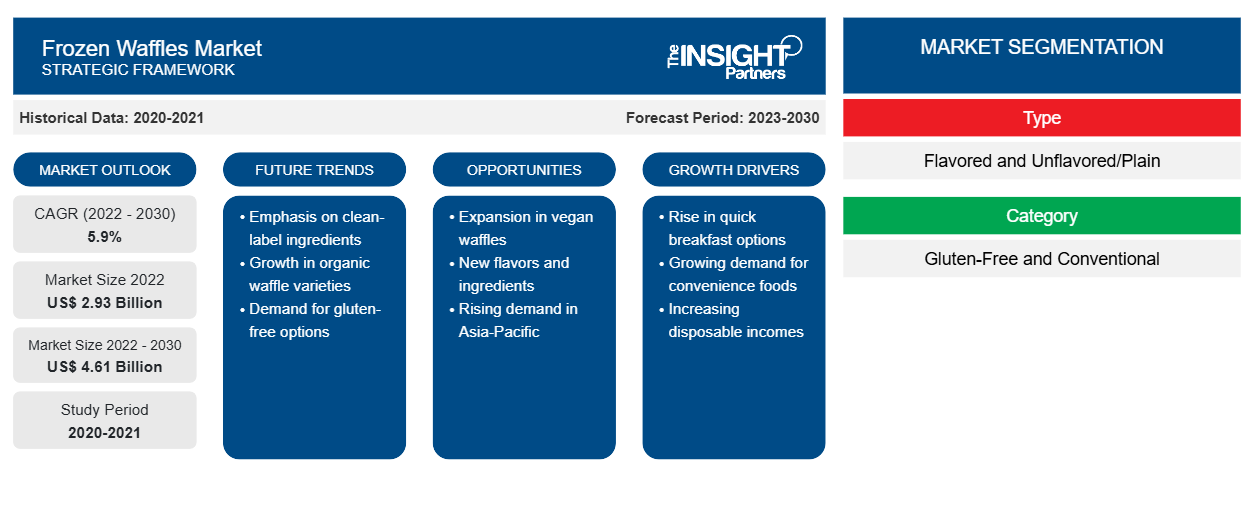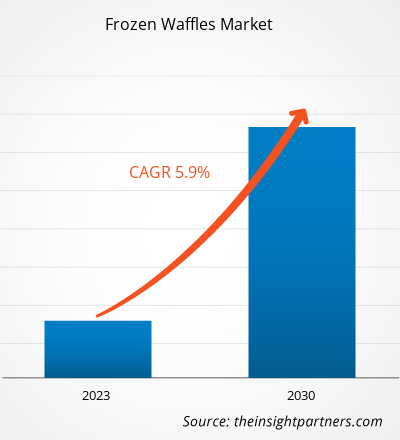[Research Report] The frozen waffles market size is expected to grow from US$ 2,925.85 million in 2022 to US$ 4,612.86 million by 2030; it is estimated to register a CAGR of 5.9% from 2023 to 2030.
Frozen waffles are a convenience food product mainly consumed as breakfast. Consumers prefer ready-to-eat, microwavable, and ready-to-prepare food products as they are highly suitable for on-the-go consumption and require minimal preparation time. Owing to this, frozen waffles are witnessing increasing global demand, mainly in developed countries. Due to the strong cultural influence on people's consumption habits in various countries, including India, Japan, and China, there is a high predominance of traditional breakfast food. Thus, the adoption of frozen waffles in these countries is limited, which is creating hurdles in the growth of the frozen waffles market.
In 2022, North America accounted for the largest share of the global frozen waffles market. The market in the region is segmented into the US, Canada, and Mexico. The rising marketing campaigns is the key factor driving the market's expansion in the US. Manufacturers rely extensively on marketing strategies such as advertising and product promotions to increase sales. Manufacturers use electronic and print media to promote their brands and products. For example, in 2017, the Netflix series Stranger Things featured Kellogg Company's Eggo brand frozen waffles. This has resulted in a considerable increase in sales of frozen waffles for the company. A rise in demand for frozen waffles among all age groups drives the market in this region. Moreover, the growing awareness about the health benefits of organic products is a significant factor boosting the demand for organic breakfast products in the region. To meet the growing consumer demand, manufacturers have introduced organic waffle varieties. For instance, Nature's Path Foods, a USDA-certified manufacturer, offers a wide range of organic breakfast and snack foods, including waffles, cold cereals, granolas, hot oatmeal, bars, and cookies. The factors mentioned above are boosting the growth of the region's frozen waffle market.
Customize This Report To Suit Your Requirement
You will get customization on any report - free of charge - including parts of this report, or country-level analysis, Excel Data pack, as well as avail great offers and discounts for start-ups & universities
Frozen Waffles Market: Strategic Insights

-
Get Top Key Market Trends of this report.This FREE sample will include data analysis, ranging from market trends to estimates and forecasts.
Impact of COVID-19 Pandemic on Frozen Waffles Market
Before the COVID-19 pandemic, the frozen waffles market growth was primarily driven by the rising demand for ready-to-eat food products. However, the market faced hurdles during the first quarter of 2020 due to business shutdowns and raw material and labor shortages. The COVID-19 pandemic led to an economic recession in the initial months of 2020, which created financial difficulties for low-income and mid-income consumers.
Moreover, due to restrictions, people stayed at home and demanded ready-to-eat products, creating a demand for frozen waffles products that are easy to consume.
Market Insights
Surging Demand for Frozen and Convenience Food Worldwide
Over the past few years, the lifestyle of people globally evolved dramatically. Due to hectic work schedules, people are looking for products that save time and effort. Consumers prefer to ready-to-eat, microwavable, and ready-to-prepare food products as they are highly suitable for on-the-go consumption and require minimal preparation time. These factors are significantly boosting the demand for convenience food among consumers. Increasing population of women, high per capita income, and rising middle-class population are key factors driving convenience food consumption globally. Moreover, the number of single or two-person households is growing in various developed nations such as the US, Canada, the UK, and Germany. According to the US Census Bureau, there were 37.9 million single-person households in the US in 2022, accounting for 29% of all households. Due to the growing number of nuclear families, the demand for ready-to-eat, portion-controlled food increased. All these factors are bolstering the demand for frozen waffles.
Type-Based Insights
Based on type, the frozen waffles market is segmented into flavored and unflavored/plain. The flavored segment is expected to register a higher CAGR during the forecast period. The growing preference for waffles as a mainstream breakfast item globally is driving the demand for frozen waffles. Millennial consumers love the warm crunchy feel of waffles in different flavors. Waffle manufacturers are growing their product portfolio by introducing new flavors such as fruit, buttermilk, and cinnamon to attract consumer interest. Further, manufacturers, including Vans and the Kellogg Company, have launched flavored waffle varieties with enhanced functional properties to fulfill the population's needs. These factors are driving the market for the flavored frozen waffles segment.
The key players operating in the global frozen waffles market include DELY Wafels SRL, Kodiak Cakes LLC, Deligout Sprl, Avieta SA, Nature's Path Foods, Julian's Recipe LLC, Kellogg Co, B Boys Inc, Sara Lee Frozen Bakery LLC, and Hometown Food Co. Players operating in the global frozen waffles market focus on providing high-quality products to fulfill customer demand. They are also focusing on strategies such as investments in research and development activities, new product launches, and expanding production capacities.
Frozen Waffles Market Regional InsightsThe regional trends and factors influencing the Frozen Waffles Market throughout the forecast period have been thoroughly explained by the analysts at The Insight Partners. This section also discusses Frozen Waffles Market segments and geography across North America, Europe, Asia Pacific, Middle East and Africa, and South and Central America.
Frozen Waffles Market Report Scope
| Report Attribute | Details |
|---|---|
| Market size in 2022 | US$ 2.93 Billion |
| Market Size by 2030 | US$ 4.61 Billion |
| Global CAGR (2022 - 2030) | 5.9% |
| Historical Data | 2020-2021 |
| Forecast period | 2023-2030 |
| Segments Covered |
By Type
|
| Regions and Countries Covered |
North America
|
| Market leaders and key company profiles |
|
Frozen Waffles Market Players Density: Understanding Its Impact on Business Dynamics
The Frozen Waffles Market is growing rapidly, driven by increasing end-user demand due to factors such as evolving consumer preferences, technological advancements, and greater awareness of the product's benefits. As demand rises, businesses are expanding their offerings, innovating to meet consumer needs, and capitalizing on emerging trends, which further fuels market growth.

- Get the Frozen Waffles Market top key players overview
Report Spotlights
- Progressive industry trends in the frozen waffles market to help players develop effective long-term strategies.
- Business growth strategies adopted by developed and developing markets.
- Quantitative analysis of the frozen waffles market from 2021 to 2030
- Estimation of global demand for frozen waffles
- Porter’s Five Forces analysis to illustrate the efficacy of buyers and suppliers operating in the industry.
- Recent developments to understand the competitive market scenario
- Market trends and outlook, as well as factors driving and restraining the growth of the frozen waffles market
- Assistance in the decision-making process by highlighting market strategies that underpin commercial interest, leading to the market growth
- The frozen waffles market size at various nodes
- Detailed overview and segmentation of the market, as well as the frozen waffles industry dynamics
- The frozen waffles market size in various regions with promising growth opportunities
Global Frozen Waffles Market
Based on type, the frozen waffles market is segmented into flavored and unflavored/plain. Based on category, the frozen waffles market is bifurcated into gluten-free and conventional. Based on distribution channel, the frozen waffles market is categorized into supermarkets and hypermarkets, convenience stores, online retail, and others.
Company Profiles
- DELY Wafels SRL
- Kodiak Cakes LLC
- Deligout Sprl
- Avieta SA
- Nature's Path Foods
- Julian's Recipe LLC
- Kellogg Co
- B Boys Inc
- Sara Lee Frozen Bakery LLC
- Hometown Food Co
Frequently Asked Questions
Based on the category, which segment led the global frozen waffles market in 2022?
What are the trends observed in the global frozen waffles market?
Which type segment is the fastest growing in the frozen waffles globally?
What are the drivers for the growth of the global frozen waffles market?
In 2022, which region held the largest share of the global frozen waffles market?
- Historical Analysis (2 Years), Base Year, Forecast (7 Years) with CAGR
- PEST and SWOT Analysis
- Market Size Value / Volume - Global, Regional, Country
- Industry and Competitive Landscape
- Excel Dataset
Recent Reports
Related Reports
Testimonials
Reason to Buy
- Informed Decision-Making
- Understanding Market Dynamics
- Competitive Analysis
- Identifying Emerging Markets
- Customer Insights
- Market Forecasts
- Risk Mitigation
- Boosting Operational Efficiency
- Strategic Planning
- Investment Justification
- Tracking Industry Innovations
- Aligning with Regulatory Trends





















 Get Free Sample For
Get Free Sample For